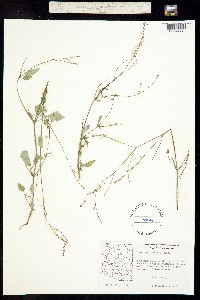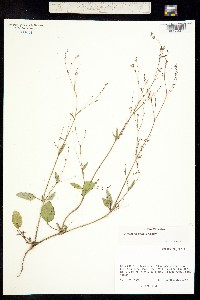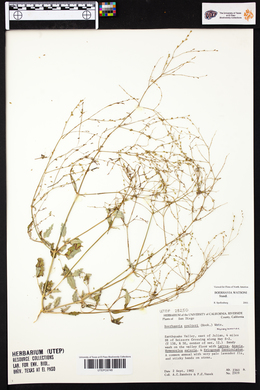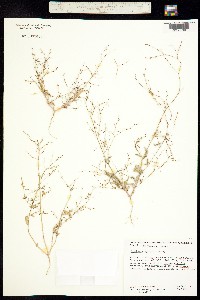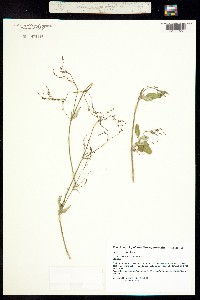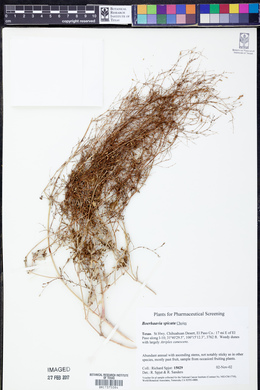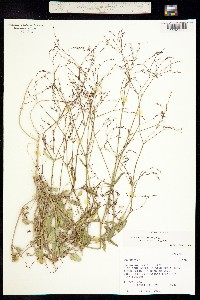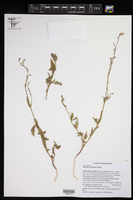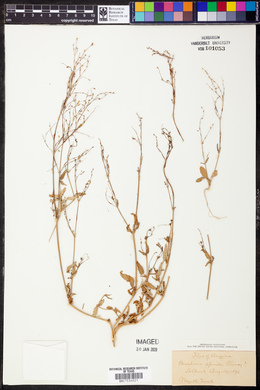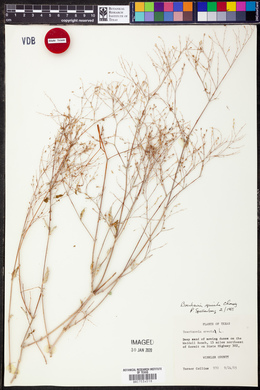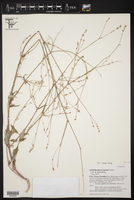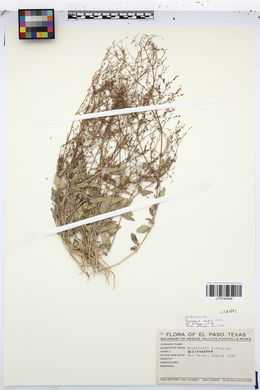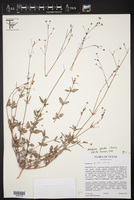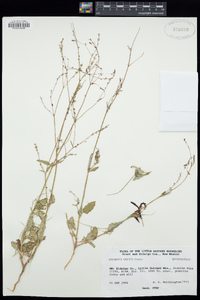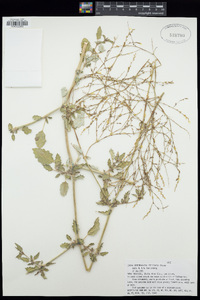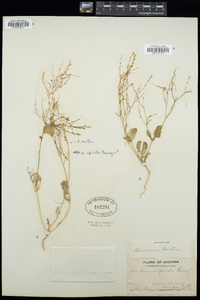Boerhavia spicata
|
|
|
|
Family: Nyctaginaceae
Creeping Spiderling, more...spiderling (es: juanamipili, juananipili, mochis)
[Boerhavia watsonii Standl.] |
Herbs, annual; taproot tapered, soft or ± woody. Stems erect or ascending, sparingly branched throughout, 30-70 dm, densely glandular-villous, or glandular-puberulent, with spreading, nonglandular hairs basally, glabrous distally. Leaves mostly in basal 1/2; larger leaves with petiole 10-30 mm, blade oval, oblong, ovate, or ± triangular, 18-45 × 13-30 mm (distal leaves usually smaller, sometimes longer, proportionately narrower), adaxial surface lightly to densely glandular-pubescent, abaxial surface paler than adaxial, lightly to densely glandular-pubescent, neither surface punctate or both minutely punctate with clusters of brown cells, base truncate, round, or obtuse, margins sinuate, sometimes crisped, apex round to obtuse, rarely acute. Inflorescences terminal and axillary, branched 1-4 times unequally, with sticky internodal bands; branches strongly ascending, terminating in spicate or racemose flower clusters, axis 10-55 mm. Flowers: pedicel 0.4-2.3[-3.7] mm; bracts at base of perianth usually soon deciduous, usually 2, narrowly to broadly lanceolate, 0.7-1.8 mm, apex often acuminate; perianth white to pale pink, campanulate distal to constriction, 1-1.3 mm; stamens (2-)3, slightly exserted or included. Fruits 5-33 per cluster, usually overlapping or 2-4 in group separated by small gap from next group, straw colored to grayish or reddish tan, broadly obovoid, 1.9-2.4(-2.8) × 1.1-1.3 mm (l/w: 1.7-2.1[-2.3]), apex rounded, glabrous; ribs 5, obtuse-rounded to obtuse, often with low winglike ridge, slightly rugose near sulci; sulci (0.2-)0.5 times as wide as base of ribs, slightly rugose, not papillate. 2n = ca. 52. Flowering late summer-early fall. Sandy or rocky soils in open, arid grasslands, among open shrubs or mesquite and acacia woodlands [tropical deciduous forests]; [100-]700-1800 m; Ariz., N.Mex., Tex.; Mexico. C. F. Reed (1969) and subsequent authors have included one or more of Boerhavia coulteri, B. torreyana, and B. watsoni as synonymous with B. spicata. Even when those taxa are removed, B. spicata remains a variable species, widespread at low to middle elevations in southwestern North America, and distinguished by its mostly overlapping, obovoid fruits with rather open sulci, and the glandular pubescence on basal parts of the plant.
Wiggins 1964, FNA 2003, Kearney and Peebles 1969 Duration: Annual Nativity: Native Lifeform: Forb/Herb General: Annual herb, to 65 cm tall, from a taproot; stems erect or trailing along the ground, often red-tinged, the stems below the inflorescence densely covered with gland-tipped hairs. Leaves: Opposite along the stems, the lower leaves on petioles about half as long as the leaf blade, and upper leaves subsessile; blades ovate to lanceolate, 1-5 cm long, with a pointed tip and a smooth or slightly wavy margin; leaf surfaces puberulent or short-villous, and often glandular. Flowers: Small and pale pink, in short, dense slender spikes at the tips of slender panicle branches; panicle branches of unequal lengths and with sticky bands between the nodes; each flower subtended by a pair of early-deciduous bracts; sepals appearing petal-like, 1 mm long or a little longer, fused into a bell-shape, white to pale pink; petals absent. Fruits: Achenes straw-colored to grayish or reddish-tan, 2 mm long, obovoid, with 5 smooth, broad longitudinal ridges. Ecology: Found on sandy soil, plains, washes, arroyos, and disturbed habitats, from 1,500-4,500 ft (457-1372 m); flowers September-October. Distribution: AZ, NM, and TX; south to MEX Notes: Widespread and distinguished by its narrowly obovoid fruit, along with its 1-2 mm-long flowers. Distinguished from several other Boerhavia spp by its flowers being arranged in spikes or racemes at branch tips, whereas other species have more or less umbel-like clusters of flowers at branch tips. B. torreyana and B. coulteri also have flowers arranged in spikes, but those species have stems that can be somewhat hairy near the base of plant, and do not have glandular hairs as in B. spicata. Some authors have lumped this taxon with B. torreyana and B. coulteri, but FNA (2004) and Allred (2012) recognize both of those as separate species. Ethnobotany: The Mayo of northern Mexico used the leaves to make a tea to treat measles. Etymology: Boerhavia named for Dutch botanist Hermann Boerhaave (1663-1738); spicata refers to the spicate flowers. Synonyms: Boerhavia watsonii Editor: SBuckley 2010, AHazelton 2017 |
|
|
|
























